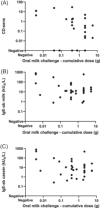Basophil allergen threshold sensitivity to casein (casein-specific CD-sens) predicts allergic reactions at a milk challenge in most but not all patients
- PMID: 38722265
- PMCID: PMC11080960
- DOI: 10.1002/iid3.1265
Basophil allergen threshold sensitivity to casein (casein-specific CD-sens) predicts allergic reactions at a milk challenge in most but not all patients
Abstract
Background: The basophil activation test is an emerging clinical tool in the diagnosis of cow's milk allergy (CMA). The aim was to assess the association between the basophil allergen threshold sensitivity to the major milk protein casein (casein-specific CD-sens), the levels of milk- and casein-specific Immunoglobulin E antibodies (IgE-ab), and the severity of allergic reactions at milk challenges.
Methods: We enrolled 34 patients aged 5-15 (median 9) years who underwent a double-blind placebo-controlled milk-challenge (DBPCMC) as screening before inclusion in an oral immunotherapy study for CMA. The severity of the allergic reaction at the DBPCMC was graded using Sampson's severity score. Venous blood was drawn before the DBPCMC. Milk- and casein-specific IgE-ab were analyzed. Following in vitro stimulation of basophils with casein, casein-specific CD-sens, was determined.
Results: Thirty-three patients completed the DBPCMC. There were strong correlations between casein-specific CD-sens and IgE-ab to milk (rs = 0.682, p < .001), and between casein-specific CD-sens and IgE-ab to casein (rs = 0.823, p < .001). There was a correlation between the severity of the allergic reaction and casein-specific CD-sens level (rs = 0.395, p = .041) and an inverse correlation between casein-specific CD-sens level and the cumulative dose of milk protein to which the patient reacted at the DBPCMC (rs = -0.418, p = .027). Among the 30 patients with an allergic reaction at the DBPCMC, 67% had positive casein-specific CD-sens, 23% had negative casein-specific CD-sens, and 10% were declared non-responders.
Conclusion: Two thirds of those reacting at the DBPMC had positive casein-specific CD-sens, but reactions also occurred despite negative casein-specific CD-sens. The association between casein-specific CD-sens and the severity of the allergic reaction and cumulative dose of milk protein, respectively, was moderate.
Keywords: CD‐sens; basophil activation; casein; cow's milk allergy; food challenge.
© 2024 The Authors. Immunity, Inflammation and Disease published by John Wiley & Sons Ltd.
Conflict of interest statement
CEW has received research funding from Thermo Fisher Scientific, which was directly paid to the institution, and speaker honorarium from Aimmune Therapeutics, a Nestlé Health Science company, outside of the submitted work. CN has received funding from the institution for participating in studies and Advisory board at Aimmune Therapeutics, a Nestlé Health Science company and speaker honorarium from MEDA, ALK, and GSK outside of the submitted work. The other authors declare no conflict of interest.
Figures




References
-
- Schoemaker AA, Sprikkelman AB, Grimshaw KE, et al. Incidence and natural history of challenge‐proven cow's milk allergy in European children—EuroPrevall birth cohort. Allergy. 2015;70(8):963‐972. - PubMed
-
- Elizur A, Rajuan N, Goldberg MR, Leshno M, Cohen A, Katz Y. Natural course and risk factors for persistence of IgE‐mediated cow's milk allergy. J Pediatr. 2012;161(3):482‐7. e1. - PubMed
-
- Muraro A, Werfel T, Hoffmann‐Sommergruber K, et al. EAACI food allergy and anaphylaxis guidelines: diagnosis and management of food allergy. Allergy. 2014;69(8):1008‐1025. - PubMed
-
- Sampson HA. Anaphylaxis and emergency treatment. Pediatrics. 2003;111:1601‐1608. - PubMed
Publication types
MeSH terms
Substances
Grants and funding
- Ellen, Walter and Lennart Hesselman Foundation for Scientific Research
- RV 832 441/Västerbotten Läns Landsting
- RV 864 981/Västerbotten Läns Landsting
- RV 941 767/Västerbotten Läns Landsting
- RV 969 865/Västerbotten Läns Landsting
- RV932 940/Västerbotten Läns Landsting
- 851 551/VISARENORR
- 930736/VISARENORR
- JLL-559111/Jämtland/Härjedalen County Council
- JLL-652181/Jämtland/Härjedalen County Council
- JLL-738681/Jämtland/Härjedalen County Council
- JLL-851571/Jämtland/Härjedalen County Council
- JLL-930965/Jämtland/Härjedalen County Council
- JLL-939570/Jämtland/Härjedalen County Council
- JLL-968247/Jämtland/Härjedalen County Council
- Swedish Asthma and Allergy Foundation
- RS 2019-1054/Stockholm läns landsting
- Insamlingsstiftelsen Cancer- och Allergifonden
LinkOut - more resources
Full Text Sources

